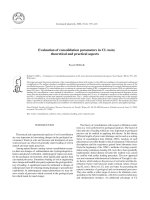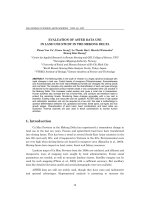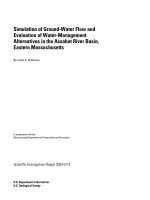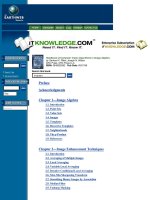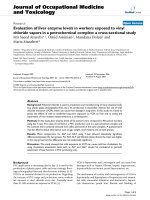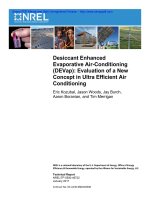Evaluation of the performance of supervised classification alogorithums in image classification
Bạn đang xem bản rút gọn của tài liệu. Xem và tải ngay bản đầy đủ của tài liệu tại đây (292.58 KB, 10 trang )
Int.J.Curr.Microbiol.App.Sci (2019) 8(10): 2634-2643
International Journal of Current Microbiology and Applied Sciences
ISSN: 2319-7706 Volume 8 Number 10 (2019)
Journal homepage:
Original Research Article
/>
Evaluation of the Performance of Supervised Classification
Alogorithums in Image Classification
Jhade Sunil* and Abhishek Singh
Department of Farm Engineering (Agricultural Statistics), Banaras Hindu University,
Varanasi, India
*Corresponding author
ABSTRACT
Keywords
Remote sensing;
Land use pattern;
Supervised
Classification;
Classification
Accuracy; kappa
coefficient
Article Info
Accepted:
18 September 2019
Available Online:
10 October 2019
This study presents a land use pattern classification of satellite imagery. The Machine
learning algorithms are overseen to pattern classifications. The supervised classifier is
identifying the classes using trained set. Compiled classification has to be improvised
using efficient algorithms with appropriate threshold values. The statistical significance of
satellite image classifies into essential classes is of greater importance in remote sensing
pattern classification methods. Test imagery were obtained through Sentinel-2B Satellite
on 15th January 2018 for Ambaji Durga Hobli, Chikkaballapur District. Maximum
Likelihood Classification, Minimum Distance to means Classification, Mahalanobis
Distance Classification, Spectral Correlation Mapper Classification were performed using
ArcGIS 10.5.1 and ERDAS 2015 imagine image processing soft wares. Accuracy of the
classification expressed using confusion matrix. The measures such as overall accuracy, Fmeasure value, Kappa coefficients its variance were estimated. The test of significance of
the Kappa coefficient was performed using Z- test. Maximum likelihood classification out
performed with highest overall accuracy of 72.99 per cent followed by Minimum distance
to mean 68.61 per cent, Mahalanobis distance 61.31 per cent, Spectral correlation mapper
56.20 per cent This study helps the farmers using early and accurate estimates of yields,
estimate area of crop production.
Introduction
Remote sensing can be defined as the
collection and interpretation of information
about an object, area, or event without being
in physical contact with the object. Remote
sensing of nature by geographers is generally
finished with the assistance of mechanical
devices known as sensors. These contraptions
have an incredibly enhanced capacity to get
and record data around a protest with no
physical contact. Regularly, these sensors are
situated far from the question of enthusiasm
by utilizing helicopters, planes, and satellites.
Sensors depends on the property of the
material (auxiliary, substance, and physical),
surface coarseness, an angle of incidence,
intensity, and wavelength of radiant energy.
The geographic information system (GIS) is a
system of hardware, software, and procedures
2634
Int.J.Curr.Microbiol.App.Sci (2019) 8(10): 2634-2643
to facilitate the management, manipulation,
analysis, modeling, representation, and display
of geo referenced data to solve complex issues
regarding planning and management of
resources. In supervised classification, spectral
features a few regions of known land use types
are removed from the image. These areas are
known as the training areas. Each pixel in the
entire image is then classified as belonging to
one of the classes depend upon how shut its
spectral highlights are to the spectral features
of the training areas. Surely understood
example:
minimum
distancemean
classification,
Maximum
Likelihood
classification,
Mahalanobis
distance
classification, and spectral correlation mapper.
Application of remote sensing and GIS in
agriculture was identification, area estimation
and monitoring, crop nutrient deficiency
detection, soil mapping, crop condition
assessment, reflectance modeling, crop yield
modeling and production forecasting.
Shamsudheen et al. (2005) have studied land
use /land cover mapping for Kumata taluk of
Uttar Kannada of Karnataka. The IRS ID LISS
III image was used. To perform supervised
maximum likelihood classification. The
accuracy of classification was evaluated using
stratified sampling method. The overall
accuracy of 75 percent was obtained. Sharma
and Leon (2005) was studied on the
supervised classification using Maximum
likelihood algorithm on three dates of IRS
LISS3 satellite data identify the outcome of
seasonal spectral variation on land use land
cover.classification for the study area falling
in the Sloan district of Himachal Pradesh
state.It was found that summer data set was
better with overall accuracy 76 percent as
relating to winter and spring dataset with
classification accuracy 49 percent and 46
percent
respectively.
Madhura
and
Venkatachalam (2013) have a classification of
different land use land cover categories from
the raw satellite image using supervised
classifiers and performances of the classifiers
are studied. Classification is performed based
on the spectral features using Maximum
likelihood classification algorithm, Minimum
distance to mean classification algorithm, and
Mahalanobis
classification.
Maximum
likelihood produced the 93.33% overall
efficiency and minimum distance showed the
overall classification accuracy of 85.72% and
Mahalanobis gave the overall accuracy of
90.00%. Patil et al. (2014) have studied
Classification of the Remote sensing satellite
imageriesarecolor pixels variability of
patterns. Machine learning techniques take
carried the improved in accuracy of
classification of patterns of features.
Challenges in the estimation of various
features viz, crop fields, fallow land,
buildings, roads, rivers, water bodies, forest,
and other trivial items. The study achieved
more than 95% classification accuracy in
agricultural crops. Manish and Rawat (2015)
have studied the Digital change identification
techniques by using multi-temporal satellite
imagery helps in understanding landscape
dynamics. The Supervised classification
methodology has been employed using
maximum likelihood technique in ERDAS 9.3
Software. Image categorized into five different
classes namely vegetation, agriculture, barren,
built-up and water body. Accuracy assessment
of the land use classification results obtained
showed an overall accuracy of 90.29 percent
for 1990 and 92.13 percent for 2010. The
Kappa coefficients for 1990 and 2010 maps
were 0.823 and 0.912 respectively.
Materials and Methods
Description of the Study Area
The study area consists of Ambaji Durga
Hobli of chikkaballapur district of Karnataka
state. The area lies between 78°3'21.64"E
longitude and 13°24'37.96"N latitude.
2635
Int.J.Curr.Microbiol.App.Sci (2019) 8(10): 2634-2643
Figure.1 Location map of study area
8) Others
9) Others
Details of image data
Data was taken from sentinel -2B Satellite
image of 15th January 2018 is used for the
study. The image collected from Karnataka
state remote sensing application center
(KSRSAC) Government of Karnataka,
Bengaluru-560097. Sentinel-2B is a European
optical imaging satellite.The satellite holds
wide swath high-resolution multispectral
imager with 13 spectral bands. The spatial
resolution of the imageries is 10 meters. The
images were recorded in three spectral bands,
Blue (0.490-0.52µm), Green (0.560-0.58µm),
and Red (0.665-0.688µm) and near Infrared
(0.842-0.86µm). ArcGIS and ERDAS
software used for structures extraction and
study.
Details of Land Use Pattern Classes
Considered
In the current study, a broad land use pattern
classification system is adopted with eight
categories for each training area as follows.
1) Agricultural crops
2) Horticultural crops
3) Grazing land
4) Forest
5) Water bodies
6) Roads
7) Build-ups
Methods of Image Classification
Image classification is the process of
separating the image into diverse areas with
some similarities and labelling the regions
using additional ground truth information. In
the
present
study,
four
supervised
classification methods namelyMaximumlikelihood algorithm, Mahalanobis distance
algorithm, Minimum distance to means
algorithm, spectral correlation Mapper, are
used for image classification.Supervised
classification is the technique most often used
for the quantitative analysis of remote sensing
image data. At it is the core concept of
segmenting the spectral domain into regions
that can be associated with the ground cover
classes of interest to a particular application.
Maximum
Algorithm
Likelihood
Classification
Maximum Likelihood Classification is
performed, an optional output confidence
raster can also be produced. This raster shows
the levels of classification confidence. Let μ1,
μ2... μm and Σ1, Σ2... Σm represents the
population mean vectors and population
variance-covariance matrices for m classes
respectively.
2636
Int.J.Curr.Microbiol.App.Sci (2019) 8(10): 2634-2643
The observation vector Xr at pixel r belongs to
class c is distributed as a multivariate normal
distribution with mean vector μc and
covariance matrix Σc.
pixel r and the class c,
Then,
For all c=1,
Then
1
p rc
2π
p/2
1/2
1
t
exp x r μ c c1 (x r μ c )
2
Given the likelihood of pixel r fitting to class
c,
Taking natural log, we have
2…... m
The minimum distance to means classifier
assigns pixel r to class c if
For all q= 1, 2……, mclasses, q≠c
using Mahalanobis Distance
p 1 1
1 Classification
t
1
lnp rc ln ln - xAlgorithm
μ
(x
μc )
r
c
c
r
2 2π 2
2
Minimum Distance to means Classification
Algorithm
The minimum distance to mean classifier is
simplest mathematically and very efficient in
computation. When the number of training
samples per class is limited, it can be more
real to option to a classifier that does not make
use of covariance information but then instead
depends only upon the mean positions of the
spectral classes, noting that for a given
number of samples these can be more
accurately estimated than covariances. The socalled minimum distance classifier,the most
used distance calculation method is Euclidean
distance.
Symbolically let
indicate
the m land cover classes in the image with
unknown mean vectors,
. Let
X1 ,X2 ,X3 ,.......Xm represent the sample mean
vectors of the m classes estimated from the
training set.
= (
where mean is
calculated over all pixels in the training set of
class c, for c =1, 2, -----, m classes and k=1,
2...S denote the digital value of rth pixel.
=
(
.
Let Drcdenote the Euclidean distance between
The Mahalanobis distance originally refers to
a distance measure that incorporates the
correlation among the features.
Let μ1, μ2...., μm and Σ1, Σ2...., Σm denotes
the population mean vectors and population
variance-covariance matrices for m classes
respectively.
The observations vector Xr at pixel r when it
belongs to class c is distributed as a
multivariate normal distributed with mean
vector μc and covariance matrix Σc.
Then,
Spectral Correlation Mapper Classification
Algorithm
The Spectral Correlation Mapper (SCM)
method is imitative of Pearson Correlation
Coefficient that removes negative correlation
and maintains the Spectral Angular Mapper
(SAM) characteristic of minimizing the
shading effect resultant in better results. The
SCM varies from –1 to 1 and SAM varies
from 0 to 1.
The SCM algorithm method, similar to SAM,
uses the reference spectrum as defined by the
2637
Int.J.Curr.Microbiol.App.Sci (2019) 8(10): 2634-2643
investigator. SCM presents the following
formula.
R=
Classification of Accuracy Assessment
Classification accuracy is estimated using
testing data, i.e., the spatial data consisting of
pixels for which the correct classification is
known but not used in generating training
statistics.
Comparison
between
the
classification obtained by the method under
consideration and the accurate classification
using test data is made, a count of some pixels
correctly classified and misclassified are
recorded for each class in an error matrix.
determine the significance of differences
between two independent groups. The null
hypothesis is that the two samples of
frequencies come from the same population.
The values of are distributed approximately
as chi-square with (r-1) (k-1) degrees of
freedom, where r = number of rows and k
=number of columns.
Results and Discussion
The results are obtained from the satellite
image with efficient land use classification by
different algorithms and measure the accuracy
assessment of classification are presented as
following subsections.
The error matrix is a rectangular array of
numbers in rows and columns which express
the number of pixels assigned to a particular
category comparative to the actual category as
verified by test data set.
Collection and Classification of satellite
image with different algorithms
While Kappa coefficient (K) is the measure of
agreement of accuracy. It provides a
difference measurement between the observed
agreement of two maps and agreement that is
contributed by chance alone.
Classification
algorithms
The overall accuracy is generally expressed as
a percent, with 100% accuracy being a perfect
classification where all reference site was
classified correctly. Overall accuracy is the
easiest to analyze and understand but
ultimately only provides the map user and
producer with basic accuracy information.
Chi-square
test for goodness of fit:
When the data consist of frequencies in
discrete categories, the
test may be used to
Validate the Classification
Coefficient.
of
data
with
by
Kappa
different
The basic steps for supervised classification as
revealed in chapter III under Section 3.2.1 is
as followed. Once the groups of interest are
defined sampleof homogeneous pixels are
selected as training sites of each group by
drawing polygons on the false color composite
images. These training sites are used to
produce statistical descriptors for each land
use land cover class. The statistics obtained
for the training sites of each class for the study
area is presented in the Tables.
Maximum Likelihood Classification
Each pixel is classified into training site which
one of the land use classes defined in chapter
III.Table 4.1 reviled the confusion matrix of
Maximum
likelihood
classification
distribution
of
classes
in
different
2638
Int.J.Curr.Microbiol.App.Sci (2019) 8(10): 2634-2643
categories.Table 4.5reviled F Measures
estimated for different classification.
Minimum Distance to Means Classification
Each pixel classified into one of land use land
cover classes described in chapter III Table
4.2shows the confusion matrix of Minimum
distance to mean classification distribution of
classes in different classes. Table 4.5 reviled F
Measures
estimated
for
different
classification.
Mahalanobis Distance Classification
Every single pixel is classified into any one of
the land cover classes described in chapter III
Table 4.3 shows the confusion matrix of
Mahalanobis
distance
classification
distribution of classes in different categories.
Table 4.6reviled F Measures estimated for
different classification.
Spectral Correlation Mapper
The confusion matrix of Spectral Correlation
mapper algorithm shows in table 4.4. Each
pixel in that image is classified as any one of
the land use class. Spectral correlation mapper
described in chapter III. Table 4.6 reviled F
Measures
estimated
for
different
classification.
Table.1 Classification satellite image result obtained from Maximum Likelihood Classification
algorithm for Ambaji Durga Hobli.
Classification
categories
1. Agricultural crops
2. Horticultural crops
3. Grazing
4. Forest
5. Water bodies
6. Built-ups
7. Roads
8. Others
Total
1
12
.
1
2
.
2
.
1
18
2
.
6
.
.
.
1
5
.
12
3
1
.
8
.
.
.
1
.
10
Reference categories
4
5
6
.
.
.
1
.
.
.
.
.
13
1
.
.
3
.
3
.
17
2
1
7
.
.
.
19
6
24
7
.
1
.
.
.
3
33
.
37
8
.
.
.
.
.
2
.
9
11
Total
13
8
9
16
3
28
49
10
137
Table.2 Classification satellite image result obtained from Minimum Distance to Means
Classification algorithm
Classification
Reference categories
Categories
1
2
3
4
5
6
7
8
Total
11
1
.
1
.
.
.
.
13
1. Agricultural crops
3
10
.
3
.
1
2
.
19
2. Horticultural crops
.
.
7
1
.
.
1
1
10
3. Grazing
.
.
.
9
.
.
.
.
9
4. Forest
.
.
.
1
5
.
.
.
6
5. Waterbodies
1
.
.
2
1
18
5
.
27
6. Built-ups
1
.
1
.
.
.
26
2
30
7. Roads
2
1
2
2
.
5
3
8
21
8. Others
Total
18
12
10
19
6
24
37
11
137
2639
Int.J.Curr.Microbiol.App.Sci (2019) 8(10): 2634-2643
Table.3 Classification satellite image result obtained from Mahalanobis Distance Classification
algorithm
Classification
Categories
1. Agricultural crops
2. Horticultural crops
3. Grazing
4. Forest
5. Waterbodies
6. Built-ups
7. Roads
8. Others
Total
1
10
.
1
.
.
2
5
.
18
2
.
4
.
2
.
1
5
.
12
3
.
.
5
.
.
3
2
.
10
Reference categories
4
5
6
7
.
.
.
3
.
.
.
1
.
.
.
.
14
.
.
.
.
3
.
.
3
1
18
5
2
2
6.
27
.
.
.
1
19
6
24
37
8
.
1
.
.
.
.
7
3
11
Total
13
6
6
16
3
33
56
4
137
Table.4 Classification satellite image result obtained fromSpectral Correlation Mapper
Classification
Categories
1. Agricultural crops
2. Horticultural crops
3. Grazing
4. Forest
5. Waterbodies
6. Built-ups
7. Roads
8. Others
Total
1
13
.
.
2
.
1
1
1
18
2
.
6
.
2
.
3
.
1
12
3
1
1
4
1
.
1
2
.
10
Reference categories
4
5
6
7
2
1
.
2
1
.
.
1
.
.
1
12
.
.
4
.
3
1
1
2
15
5
2
2
5
19
.
.
2
5
19
6
24
37
8
.
2
.
.
1
2
1
5
11
Total
19
11
5
21
6
29
32
14
137
Table.5 F Measures estimated for different classification category using Maximum likelihood
classification and Minimum Distance to Means classification.
Classification
Algorithm
Classification Category
1. Agricultural crops
2.Horticultural crops
3. Grazing
4. Forest
5. Water bodies
6. Built ups
7. Roads
8. Others
Maximum Likelihood
Classification
FProducers
User’s
measure
accuracy
accuracy
F=2rp/r+p (per cent) (Per cent)
0.77
66.67
92.31
0.60
0.84
0.74
0.66
0.65
0.73
0.85
50.00
80.00
68.42
50.00
70.83
84.62
81.82
75.00
88.89
81.25
99.99
60.71
64.71
90.00
2640
Minimum Distance to Means
FProducers
measure
accuracy
F=2rp/r+p (per cent)
0.71
61.11
0.65
0.70
0.64
0.83
0.72
0.77
0.47
83.33
70.00
47.37
83.33
75.00
70.28
72.73
User’s
accuracy
(Per cent)
84.62
52.63
70.00
99.99
83.33
69.23
86.25
34.78
Int.J.Curr.Microbiol.App.Sci (2019) 8(10): 2634-2643
Table.6 F Measures estimated for different classification category usingMahalanobis Distance
classification andSpectral Correlation Mapper classification.
Classification
Algorithm
Classification
Category
Mahalanobis Distance
Classification
FProducers
User’s
measure
accuracy
accuracy
F=2rp/r+p (per cent)
(Per cent)
0.65
55.56
76.92
Agricultural
1.
crops
2.Horticultural
crops
3. Grazing
4. Forest
5. Water bodies
6. Built ups
7. Roads
8. Others
Spectral Correlation Mapper
FProducers
measure
accuracy
F=2rp/r+p (per cent)
0.70
72.22
User’s
accuracy
(Per cent)
68.42
0.44
33.34
66.67
0.52
50.00
54.55
0.62
0.80
0.66
0.63
0.59
0.40
50.00
73.68
50.00
75.00
72.97
27.28
83.33
87.50
99.99
54.55
48.21
75.00
0.54
0.60
0.50
0.57
0.55
0.40
40.00
63.16
50.00
62.50
51.35
45.45
80.00
57.14
50.00
51.73
59.35
35.71
Validate The Classification By Kappa
Coefficient.
Test of significance is performed for Kappa
coefficients of each method. Test of
significant difference between Kappa
coefficients of different methods. Table 4.7
shows the test of significance of kappa
coefficient at 1 percent level. All these
classification algorithms show a variance of
kappa value is less than 0.01 it means
significance of kappa confident of all
classified algorithms are significance at one
percent level for the image.
The validity of classification accuracy was
assessed using Kappa statistics which
measures the degree of concordance. Overall
accuracy of all supervised classification
shows Table 4.7.
Table.7 Test of significance of Kappa coefficient for study area
Classification Algorithm
Maximum Likelihood
Kappa (K)
Variance of K
p-Value
Overall accuracy
0.68
0.00172
< 0.01
72.99
68.61
0.00184
< 0.01
61.31
0.00204
< 0.01
56.20
0.00210
< 0.01
accuracy Highest overall accuracy in
Kappa coefficient of maximum likelihood is
Maximum likelihood classification 72.99
(0.68), Minimum distance to means
percent lowest overall accuracy found in
(0.63),Mahalanobis
Distance(0.52)
and
Spectral Correlation Mapper56.20 percent.
Spectral Correlation Mapper (0.48). Overall
Minimum distance to means
Mahalanobis Distance
Spectral Correlation Mapper
0.63
0.52
0.48
2641
Int.J.Curr.Microbiol.App.Sci (2019) 8(10): 2634-2643
Area estimated with classifications and
Ground truth values
The Maximum likelihood classification is
achieved the estimation of categories which is
found to be more significant on truth
observation in case of most of the classes
compare to unsupervised classification.
Shows Table.8.
Table.8 Area estimated with classifications and Ground truth values.
Classes
Maximum
likelihood
Agricultural crops
Horticultural
crops
Grazing
Forest
Water bodies
Built-ups
Roads
others
3376.28
2810.30
Minimum
distance to
means
3183.63
2642.70
895.91
2063.27
1270.33
593.65
968.83
2925.48
794.54
2591.38
1125.75
926.63
1237.29
2402.16
Chi-square (
) test for goodness of fit.
In this technique we are comparing the
significant difference between the ground
Mahalanobis
distance
2864.19
3165.42
Spectral
correlation
mapper
2643.29
2294.68
Ground
truth
3418.73
2994.16
568.51
1263.04
938.69
2663.72
3568.92
2142.52
980.48
1129.73
1300.09
1139.78
873.48
614.56
432.79
582.52
721.62
3089.39
2548.34
2774.25
truths frequencies with the frequencies
obtained with the two classification
algorithms to each result is presented in below
table.
Table.9 Test of significance of chi-square for Ambaji Durga Hobli satellite image
Classifiers
Maximum Likelihood
Minimum Distance
Mahalanobis Distance
Spectral Correlation Mapper
**:significant at 1 percent level.
Chi square value
520.12**
441.86**
345.13**
257.11**
Table 4.9 shows a test of significance of chisquare for the study area of the satellite image
maximum likelihood classification algorithm
nearer to the ground truth value. It found that
highest probability (2.02E-16), next highest
probability (1.92E-05) observed in a
minimum distance to mean classification,
Mahalanobis distance classification shows
(1.6E-12),spectral correlation mapper shows
(1.38E-68) p-value.
p- value
2.02E-16
1.92E-05
1.60E-12
1.38E-68
In Agriculture, satellites have a capability to
image individual fields, regions and counties
on a frequent reenter cycle. Digital image
analysis is a vital role in remote sensing area
like land use land cover classification. The
spectral response of a particular land cover
class deviates from its ideal response due to
the presence of noise. Application of
statistical methods in remote sensing image
classification in order to partition the noisy
2642
Int.J.Curr.Microbiol.App.Sci (2019) 8(10): 2634-2643
image into its constituent classes is of great
importance.
Maximum
likelihood
classification algorithm is observed to be best
with a highest overall accuracy of 72.99
percent for a study area. Maximum likelihood
algorithm is a parametric method of
Classification which depend on the Gaussian
probability model for each class. It classified
is based on variance-covariance matrices for
each class, In case of Minimum distance to
mean classification which makes use of mean
vectors of training sets to assign an unknown
pixel to the category using Euclidean
distance, the overall accuracy of 68.61
percent attained for the study area, it is
standing next to Maximum Likelihood.
Mahalanobis distance classification which
considers mean vectors and population
variance-covariance matrices for each class,
the overall accuracy of 61.31 percent of the
study area, stands next to maximum
likelihood and minimum distance to mean
classification. Spectral correlation mapper it
is based on targeted spectrum and reference
spectrum, the overall accuracy 56.20 percent.
The future line of work:
The maximum likelihood classification is
superior method among classifiers, for of land
areas and production estimates through
classification procedures.The study can be
extended to large area say for taluk, districts,
classification according to the land use and
land cover status, was helped to control and
supervision the main quantity about land use
types and the implementation of the plans.
References
Madhura, Suganthi. and Venkatachalam.,
2013, Comparison of supervised
classification methods on remote sensed
satellite data an application in Chennai,
India.International journal of science
and research, 6(14):128-143.
Manish, Kumar.and Rawat, J.S., 2015,
Monitoring land use/cover change using
remote sensing and GIS techniques: A
case study of Hawalbagh black, district
Almora, Uttarkhanda, India, The
Egyptian J.Remote Sensing and Space
Sci., 18(5):77-84.
Patil, S.S., Sachidanad, U.B., Angadi and
Prabhuraj, D. K., 2014, Machine
Learning Technique Approaches verses
Statistical methods in Classification of
multispectral remote sensing data using
Maximum Likelihood Classification.
Int. J. Adv. Remote Sensing and
GIS.3(1): 525-531.
Shamsudheen, M., Dasog, G. S. and
Tejaswini, B., 2005, Land use /land
cover mapping in the coastal area of
North Karnataka using remote sensing.
J.
Indian Soci. Of Remote Sens.,
33(1):155-163.
Sharma, D.P. and Bren, Leon., 2005, Effect of
seasonal spectral variation on land cover
classification, J. Indian Soci. Of Remote
sens., 33(2):203-209.
How to cite this article:
Jhade Sunil and Abhishek Singh. 2019. Evaluation of the Performance of Supervised
Classification Alogorithums in Image Classification. Int.J.Curr.Microbiol.App.Sci. 8(10):
2634-2643. doi: />
2643
